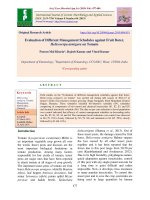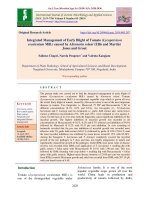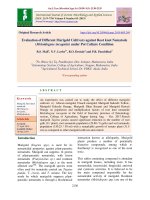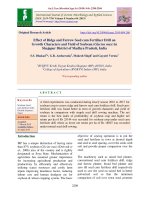Effect of Trichoderma spp. against root-knot nematode (Meloidogyne incognita) on tomato (Lycopersicon esculentum L. Mill)
Bạn đang xem bản rút gọn của tài liệu. Xem và tải ngay bản đầy đủ của tài liệu tại đây (209.15 KB, 8 trang )
Int.J.Curr.Microbiol.App.Sci (2018) 7(12): 746-753
International Journal of Current Microbiology and Applied Sciences
ISSN: 2319-7706 Volume 7 Number 12 (2018)
Journal homepage:
Original Research Article
/>
Effect of Trichoderma spp. against Root-Knot Nematode
(Meloidogyne incognita) on Tomato (Lycopersicon esculentum L. Mill)
Mumpi Ering* and Sobita Simon
Department of Plant Pathology, Sam Higginbottom University of Agriculture, Technology
And Sciences, Allahabad- 211007 (U.P), India
*Corresponding author
ABSTRACT
Keywords
Root-knot
nematodes,
Meloidogyne
incognita,
Biocontrol,Trichode
rma isolates,
Tomato
Article Info
Accepted:
07 November 2018
Available Online:
10 December 2018
The root-knot nematode (Meloidogyne incognita) is one of the important
pathogen of Tomato plant in India. Pot experiments conducted for the
evaluation of effect of Trichoderma species against root knot Nematode
(Meloidogyne incognita) in Tomato. The results revealed that the
Treatments T4proved to be the most effective treatment that showed better
larval mortality (54.55% @24 hrs and 65.12% @48 hrs) and reduction in
nematode population (113.33 %) and root gall/ root system(74.89%. The
treatment of the soil with the antagonistic fungus improved nematode
control as the isolates significantly reduced the nematode populations. The
fungus enhanced plant growth and yield in all the treated pots.
Introduction
“Tomato (Lycopersicon esculentum L. MILL)
is a major crop of world commerce and one of
the most widely grown vegetables. It belongs
to the family of Solanaceae, which contains
about 85 genera and 2,300 species. Tomato is
mostly affected by root- knot nematode
(Meloidogyne
spp)
Bhardwaj
(1972).
Common species causing root- knot in tomato
are Meloidogyne incognita, Meloidogyne
javanica. Root-knot infection causes 24-26%
loss in Tomato Sasser., (1979).
Root-knot nematodes (RKNs, Meloidogyne
spp.) are sedentary, polyphagous root
endoparasites and among the most damaging
agricultural pests, attacking a wide range of
crops. Their infection starts with root
penetration of second-stage juvenies (J2),
hatched in soil from eggs stored in egg masses
that have been laid by the females on the
infected roots Barker et al., (1985).
The plants infected with root-knot nematodes
have an unthrifty appearance and often show
symptoms of yellowing, rotting, wilting and
746
Int.J.Curr.Microbiol.App.Sci (2018) 7(12): 746-753
premature shedding of the foliage with severe
stunting that result in huge losses to the
infected crops Saifullah et al., (1990).
Trichoderma isolates have been used
successfully to control the damage caused by
soil-borne pathogens in greenhouses and
under opened-field conditions. Trichoderma
harzianum and Trichoderma viride were
tested for their capacity to reduce the
incidence and pathogenicity of the root-knot
nematode Meloidogyne incognita on tomato.
In vitro studies demonstrated that all tested
isolates were effective in causing second-stage
juvenile (J2) mortality compared with the
control. Trichoderma slightly reduced
nematode damage to tomato in vivo Papavizas
(1985). Devi et al., (2002) reported that T.
viride or T. harzianum when mixed in soil @
1 g/kg soil improved plant height, shoot
weight, root length and weight and reduced M.
incognita population. Goswami and Mittal
(2004) reported that the culture filtrates of T.
viride showed 60% toxicity compared to P.
lilacinus (25%) against J2s of M. incognita
infecting tomato and showed that the
inhibition of hatching of M. incognita eggs
was 65% by culture filtrates of T. viride
compared to 40% by P. lilacinus. Pathak et
al., (2005) reported that application of T.
harzianum or T. virens one week prior to
nematode inoculation @4 and 8 g/kg soil
significantly reduced the number of galls,
number of j2s penetrated/plant root system
and final Meloidogyne spp. population in soil
compared to control. Zhang et al., (2012)
reported an isolate of T. longibrachiatum that
had a strong lethal and parasitic effect on the
J2s of Meloidogyne incognita at a
concentration of 1.5 x 107 conidia/ml,
inhibited and parasitized more than 88% J2 s
in cucumber seedlings after 14 days.
Sokhandani et al., (2016) showed that T.
longibrachiatum concentrations at 108
conidia/mL suspension produced the best
plant growth and reduced the reproduction of
M. javanica. Several control measures like
cultural practices, chemical and biological
control are used to reduce the population of
the nematode but unfortunately there are many
problem associated with the use of chemical
control. Biological control is a favourable
alternative for the management of root knot
nematodes, as it is economical, sustainable
and environment friendly, thus, maintaining
soil biodiversity and health. Trichoderma
species are free living fungi, common in soil
and root ecosystem. They are being widely
investigated for their capacity to produce
antibiotics, parasitize other fungi and compete
or
antagonize
deleterious
plant
microorganisms and nematode pests Harman
et al., (2004).
Keeping in view of the above points the
present titled “ Effect of Trichoderma spp.
against Root-Knot nematode(Meloidogyne
incognita)
on
Tomato
(Lycopersicon
esculentum L. MILL)” was conducted with
the following objectives:To observe the effect of Trichoderma spp. on
larvae emergence of Meloidogyne incognita at
24 and 48 hr after exposure.
To count the number of root- knot infestation
on tomato roots at 90 days after transplanting.
Materials and Methods
The nematode inoculation: The tomato plants
were infected with root-knot nematode eggs
which isolated from the infested roots of the
eggplant (Solanum melongena L.) that
obtained from Central Research Field,
SHUATS, Allahabad. Sodium hypochlorite
(NaOCl) was utilized for isolation of
nematode eggs from root galls according to
Hussey and Barker (1973). Moreover, the
roots were stained for 15 minutes in an
aqueous solution of Phloxine B stain to detect
the presence of nematode egg masses
(Holbrook et al., 1983).
747
Int.J.Curr.Microbiol.App.Sci (2018) 7(12): 746-753
The Pots experiment: The pot experiment was
carried out using tomato plants, the Pots were
15 cm in diameter and 20 cm in depth and
each pot filled with 1kg of autoclaved
artificial mixture soil. The isolated eggs of
root-knot nematode were applied at the rate of
1000 eggs / pot. Six treatments were applied,
next to untreated check and chemical check
(carbofuron @3g per pot) and each treatment
was replicated three times, and each replicate
contains three plantlet. 90 days after planting,
the seedlings were uprooted and root systems
were assessed for galling (number of galls/root
system), and egg masses/root system, in
addition to the mortality rate and root weight.
water were taken as control.
Application of Trichoderma spp: 10ml of each
species of Trichoderma solution were applied
to the respective pots near the root zone. The
treatments were as follows; T0 Control, T11000
larvae/plant + Tr 1 (2 ×105 spores per cm3),
T21000 larvae/plant +Tr 2 (2.2 × 105spores
per cm3), T31000larvae/plant +Tr 3 (2.3
×105spores per cm3),T41000larvae/plant +Tr
4
(2.8
×105spores
per
cm3),
T51000larvae/plant +Tr 5 (2.4 ×105spores per
cm3),T61000larvae/plant +Tr 6 (2.1 ×
105spores per cm3), T71000larvae/ plant +
Carbofuron @ 3g/pot. All treatments were
applied two days after infection.
Data of the present study were analyzed using
variance test (ANOVA). The experimental
design was a complete randomized design.
The least significant differences (LSD) at the
5% level of probability were determined.
Effects of Trichoderma isolates on Mortality
of M. incognita. The effect of Trichoderma
isolates on juvenile mortality was studied
under in vitro conditions. The juveniles (J2) of
M. incognita used in this experiment were
obtained from the nematode maintained on
tomato roots. Approximately one hundred
number of second stage juveniles (J2) were
placed in 10 ml of suspension of Trichoderma
isolates contained in sterilize petri plates and
incubated at room temperature. The plates
were examined after 24 and 48 hours and the
number of dead juveniles were counted. Three
replications were maintained. The juveniles
inoculated in carbofuran 3G served as check
and the juveniles inoculated in sterile distilled
Table 2 shows the effect of Trichoderma
isolates on the larval population of
Meloidogyne incognita. All the treatments
significantly reduce the larval population
compare to the inoculated control. Among the
treatments T4 shows maximum reduction of
larval population compare to all the other
treatments.
Evaluation of Trichoderma spp. on root gall /
root system of Tomato plant. After 90 DAT
(days after transplanting), the plants were
uprooted, thoroughly washed and then fresh
weight of roots and number of galls/ plant
were recorded. Fresh galling damage was
assessed per plant of pot in the greenhouse at
harvest. The root galls of each plant were
counted and scored for number of galls and
indexing was done using 0-5 scale as follows:
(Taylor and Sasser, 1978).
Statistical analysis
Results and Discussion
Table 1 shows that all the treatments
significantly reduces the root gall/ root system
of Tomato when compared with inoculated
control. Among the treatments T4 shows
significant decreased of root galls compare to
all the other treatments.
Table 3 shows the mortality rate of
Meloidogyne incognita recorded after 24 and
48 hrs. All the treatments shows significant
increase in percentage of mortality compared
to the inoculated control. Among the
Trichoderma isolates maximum larval
mortality
was
observed
in
T4.
748
Int.J.Curr.Microbiol.App.Sci (2018) 7(12): 746-753
Table.1 Root- knot index of M. incognita
Grade
0
1
2
3
4
5
Description
No galls
1-2 galls/ root system
3-10 galls/ root system
11-30 galls/ root system
31-100 galls/ root system
>100 galls/ root system
Reaction
Highly resistant
Resistant
Moderately resistant
Susceptible
Highly susceptible
Table.2 Effect of Trichoderma spp. on root gall/ root system of Tomato plant at 90 DAT
Symbol Name of Treatments
*mean
Control
Trichoderma isolate 1
Trichoderma isolate 2
Trichoderma isolate 3
Trichoderma isolate 4
Trichoderma isolate 5
Trichoderma isolate 6
Carbofuron 3G
T0
T1
T2
T3
T4
T5
T6
T7
232.44
163.15
113.33
95.53
74.89
90.74
130.29
65.30
Galling index (0-5
scale)
5
5
5
4
4
4
5
4
*Mean of 3 replicates
Table.3 Effect of Trichoderma spp. on larval population / g of roots on Tomato plant at 90 DAI
Symbol Name of treatment
T0
T1
T2
T3
T4
T5
T6
T7
*Mean
Control
Trichoderma isolate 1
Trichoderma isolate 2
Trichoderma isolate 3
Trichoderma isolate 4
Trichoderma isolate 5
Trichoderma isolate 6
Carbofuron 3G
373.86
263.49
222.55
167
113.33
133.78
237.19
88.95
*Mean of 3 replicates
749
Int.J.Curr.Microbiol.App.Sci (2018) 7(12): 746-753
Table.4 Effect of Trichoderma spp. on mortality of second stage larvae of M.incognita after 24
hrs an d 48 hrs
Symbol
T0
T1
T2
T3
T4
T5
T6
T7
Name of Treatments
*Mean of larval mortality
Control
Trichoderma isolate 1
Trichoderma isolate 2
Trichoderma isolate 3
Trichoderma isolate 4
Trichoderma isolate 5
Trichoderma isolate 6
Carbofuron 3G
24 hrs
1.11
40.33
47.22
43.45
54.55
52.89
41.55
63.74
48 hrs
4.95
47.23
56.22
53.86
65.12
57.75
45.94
71.38
*Mean of 3 replicates
Root-knot nematodes (Meloidogyne sp.) are
sedentary endoparasites and are among the
most destructive pests of agricultural crops.
They are worldwide in distribution having a
very wide host range. Trichoderma isolates
have been used successfully to control the
damage caused by soil-borne pathogens in
greenhouses
and
under
opened-field
conditions (Papavizas, 1985). Trichoderma
species also have been shown to have activity
toward root-knot nematodes (Windham et al.,
1989; Sharon et al., 2001). This experiment
has therefore shown that Trichoderma isolates
can reduce the number of Meloidogyne
incognita juveniles’ counts, as the counts
were much lower in the treated plots than the
control plots. After 90 DAT the tomato plant
was uprooted and the number of root gall/root
system was observed (Table 4).
The highest fresh root weight was recorded on
pots with inoculated control (T0) and the
lowest root weight was observed in T7
(Carbofuron 3G). Among the treatments
Trichoderma isolate 4 showed significantly
decreased from all the other treatments
followed by Trichoderma isolates 5,
Trichoderma isolate 3, Trichoderma isolate 2,
Trichoderma isolate 6 and Trichoderma
isolate 1.
The infected roots collected were cut and
grinded and the total root population was
determined with the number of larvae in 1g
root and multiplying it with total weight of
root. The highest larval population was
recorded in T0. The lowest larval population
was observed in T7 (Carbofuron 3G). Among
the treatments T4 (Trichoderma isolate 4)
show significant decrease in larval population
followed by T5 (Trichoderma isolate 5),T3
(Trichoderma isolate 3),T2 (Trichoderma
isolate 2),T6 (Trichoderma isolate 6) and T1
(Trichoderma isolate 1). The effect of
Trichoderma isolates on juvenile mortality
was studied under in vitro conditions.
Approximately one hundred number of
second stage juveniles (J2) were placed in 10
The maximum root gall/ root system was
recorded in T0 (Control) and maximum
reduction of root galls/ root system was
observed in T7 (Carbofuron 3G).Among the
treatments T4 shows the maximum reduction
of root gall/root system followed by T5 while
minimum reduction of root gall/ root system
was observed in T1.
750
Int.J.Curr.Microbiol.App.Sci (2018) 7(12): 746-753
ml of suspension of Trichoderma isolates
contained in sterilize petri plates and
incubated at room temperature. The plates
were examined after 24 and 48 hours and the
number of dead juveniles were counted.
Among the Trichoderma isolates the
maximum larval mortality was observed in T4
(Trichoderma isolates 4) followed by T5
(Trichoderma isolate 5), T2 (Trichoderma
isolate 2), T3 (Trichoderma isolate 3), T6
(Trichoderma isolate 6), and T1 (Trichoderma
isolate 1).
beings and animals. There were more M.
incognita juveniles in the control plots that
were not treated with Trichoderma isolates
after harvest. The fungus provided gave some
level of nematode suppression as much as
synthetic nematicides. Tomato plants that
were treated with Trichoderma isolates were
less attacked by the root-knot nematodes and
also shows significant reduction in root gall/
root system of Tomato plants (Neog et al.,
2014). The untreated plants had high
nematodes population. The Trichoderma
isolates shows maximum larval mortality of
Meloidogyne incognita when recorded after
24 and 48 hrs of exposure as compared with
untreated control. There was significant
increase in growth and yield of tomato plants
treated with Trichoderma isolates compared
to those not treated with Trichoderma
isolates. This is in agreement with Sasser,
(1980) reported that root-knot nematodes
(Meloidogyne sp) are capable of causing
reduced growth rate. This observation also
agrees with those of earlier researchers;
Papavizas, 1985; Windham et al., 1989;
Sharon et al., 2001, as well as Meyer et al.,
2001 who reported the importance of
Trichoderma isolates in enhancing plant
growth, increasing crop yield and reducing
root-knot nematode population build up in the
soil as well as their damage.
It is concluded that use of bio- agents such as
Trichoderma spp can significantly enhance
our lives, the environment and our
productivity. Trichoderma species are well
known to cause antagonistic effects on plant
parasitic nematodes. The fungus enhanced
plant growth and yield in all the treated pots.
In India, various species of Trichoderma are
reported as nematicidal. Use of Trichoderma
spp against phytonematodes and as a growth
enhancer has received much attention by
many researchers. All the treatments
significantly control the root knot of Tomato
when compared with inoculated control.
Among the treatments, T4 (1000larvae/plant
+Tr4) showed better larval mortality and
reduction in nematode population, root weight
and
root
gall
followed
by
T5
(1000larvae/plant +Tr5), T3 (1000larvae/plant
+Tr5), T2 (1000larvae/ plant +Tr5),T6
(1000larvae/plant
+Tr5)
and
T1
(1000larvae/plant +Tr5) in Tomato. Thus, the
treatment of the soil with the antagonistic
fungus improved nematode control as the
isolates significantly reduced the nematode
populations.
References
Arya, H.C., 1957.Root-knot diseases of
tomatoes in Jodhpur. Science and
Culture. 22: 391-393
Barber, C.A., 1901. A tea ell worm disease in
South India. Dept. L and Record,
Madras Agricultural Branch, 2. Bull No.
45.
Barker, K. R., Carter, C. C., and Sasser, J. N.,
eds. 1985. Nematode extraction and
bioassays. In: An Advanced Treatise on
Meloidogyne: Biology and Control.
North Carolina State University,
From all these results we can conclude that
Trichoderma spp can be effectively used as
soil treatment in pots on Tomato crop for
control of M. incognita and is eco- friendly in
management of the root- knot avoiding
pollution and residual hazards to human
751
Int.J.Curr.Microbiol.App.Sci (2018) 7(12): 746-753
Raleigh.2:19-35.
Bhardwaj, A.K., Sharma, P.L., Punchog,
1972.
Root-Knot
nematode
(Meloidogyne spp) infestation on
tomato in solan area of Himachal
Pradesh. Indian journal of Nematology.
2(2) 197-198.
Devi, L. S., Richa, S., and Sharma, R., (2002).
Effect of Trichoderma spp. against rootknot nematode Meloidgyne incognita on
tomato.
Indian
Journal
of
Nematology.32 (2): 227-228.
Di Mascio, P.S., Kaiser, H., Sies. 1989.
Lycopene as the most efficient
biological carotenoid singlet oxygen
quencher. Archives of Biochemistry and
Biophysics. 274:532-8.
Goswami, B. K., and Mittal, A.,
2004.Management
of
root-knot
nematode
infecting
tomato
by
Trichoderma viride and Paecilomyces
lilacinus. Indian Phytopathology.57 (2):
235-236.
Giovannucci, E., Ascherio, A., Rimm, E.B.,
Stampfer, M.J., Colitz, G.A., Willett,
W.C., 1995. Intake of carotenoids and
retinol in relation to risk of prostate
cancer. Journal of the National Cancer
Institute 87:1767-76.
Harman, G. E., Howell, C. R., Viterbo, A.,
Chet,
I.,
and
Lorito,
M.,
2004.Trichoderma
species
Opportunistic,
avirulent
plant
symbionts.
Nature
Reviews
Microbiology, 2:43-56.
Holbrook, C. C., D. A. Knauft and D. W.
Dikson. 1983. A technique for
screening peanut for resistance to
Meloidogyne arenaria. Plant Dis. 57:
957-958.
Hussey, R. S. and K. R. Barker. 1973. A
comparison of methods of collecting
inocula on Meloidogyne spp., including
a new technique. Plant Dis. Rep.
57:1025–1028.
Meyer, S.L.F., Roberts, D.P., Chitwood, D.J.,
Carta, L.K., Lumsden, R.D., and Mao,
W., 2001. Application of Burkholderia
cepacia and Trichoderma virens, alone
and
in
combinations,
against
Meloidogyne incognita on bell pepper.
Nematropica.31: 75-86.
Neog, P. P., Manoj, K., Chauhan and Deka, S.
N., 2014. Trichoderma harzianumin
management of root knot nematode
infesting black gram. Annals of Plant
Protection Sciences. 22: 235-236.
Papavizas, G.C., 1985. Trichodermaand
Gliocladium, Biology, Ecology, and
Potential for Biocontrol. Annual Review
Phytopathology.23:23-54.
Pathak, D.K.N., Ranjan, Ritesh Kumar,
Manoj and Brijendra Kumar. 2005.Biomanagement
of
Meloidogyne
graminicola by Trichoderma harzianum
and T. virens in rice. Annals of Plant
Protection Sciences.13(2): 438-440.
Ploeg, A.T., 2002. Effect of selected Marigold
varieties on root-knot nematodes of
tomato and melon yields. Plants
Disease.86:505-508
Saifullah, A., Gul and Zulfiqar, M., 1990.
Promising control of root knot
nematodes (Meloidogyne spp.) on
tomato through organic amendments.
Sarhad Journal of agriculture, 6:417419.
SasserJN.1980 Root knot nematodes: A
global menace to crop production. Plant
Disease. 64:36–41
Sasser, J.N., 1979.Economic importance of
Meloidogne in tropical countries., In:
Root–knot Nematodes (Meloidogne
spp.) Systematics, Biology and Control
Eds. F. Lamberti and C.E. Taylor.
Academic Press, London.pp:359- 374
Sharon, E., M., Bar-Eyal, I., Chet, A., HerraEstrella, O., Kleifeld and Spiegel, Y.,
2001. Biological control of the rootknot nematode Meloidogyne javanica
by
Trichoderma
harzianum.
Phytopathology. 91: 687-693.
752
Int.J.Curr.Microbiol.App.Sci (2018) 7(12): 746-753
Sokhandani, Z., Moosavi, M. R., and
Basirnia,
T.,
2016.Optimum
Concentrations
of
Trichoderma
longibrachiatum and Cadusafos for
Controlling Meloidogyne javanica on
Zucchini Plants. Journal of Nematology.
48(1):54–63.
Taylor, A. Z., and Sasser, J. N., 1978.Biology,
identification and control of root-knot
nematode. North Carolina State Univ.
and United states Agency for
International Development, Raliegh,
N.C., USA. pp- 11.
Walker, J.C. 1983. Diseases of vegetable
crops. (1st Ed.). McGraw Hill Book Co.
Inc. New York. Pp. 431-515.
Windham, G. L., Windham, M.T. and
William, W. P., 1989.Effect of
Trichoderma spp. on Maize Growth and
Meloidogyne arenaria Reproduction,
Plant Disease, 73:493-495.
Yadav, B.S., and Pathak, A.K., 1983. Rootknot nematode Meloidogyne spp. in
Rajasthan, Proc. Natt. Adv.From Pl.
Sci.Deptt. 2001. Jodhpur University
India: 226-227.
Zhang, S., and Zhang, X., 2012. Effects of
two composted plant pesticide residues
incorporated with Trichoderma viride
on root-knot nematode in ballon flower.
Agricultural Sciences in China.8:447454.
How to cite this article:
Mumpi Ering and Sobita Simon. 2018. Effect of Trichoderma spp. against Root-Knot
Nematode (Meloidogyne incognita) on Tomato (Lycopersicon esculentum L. Mill).
Int.J.Curr.Microbiol.App.Sci. 7(12): 746-753. doi: />
753









